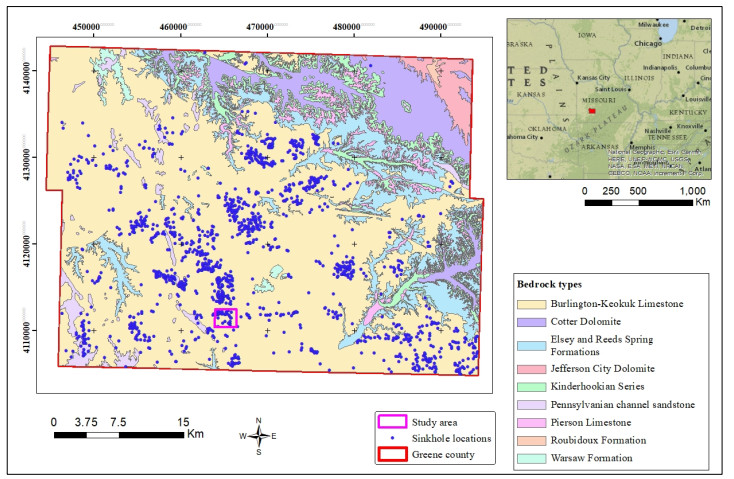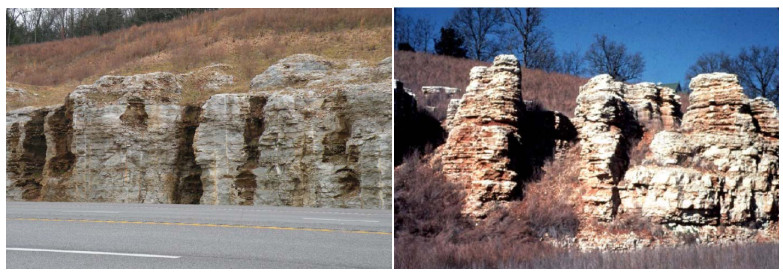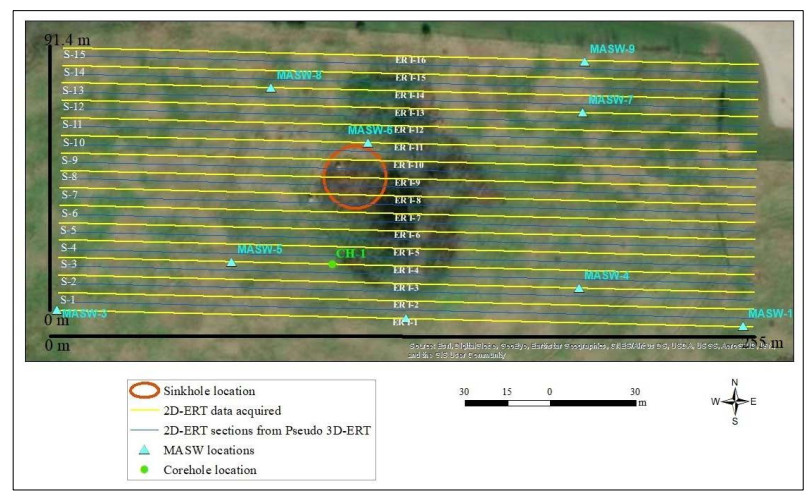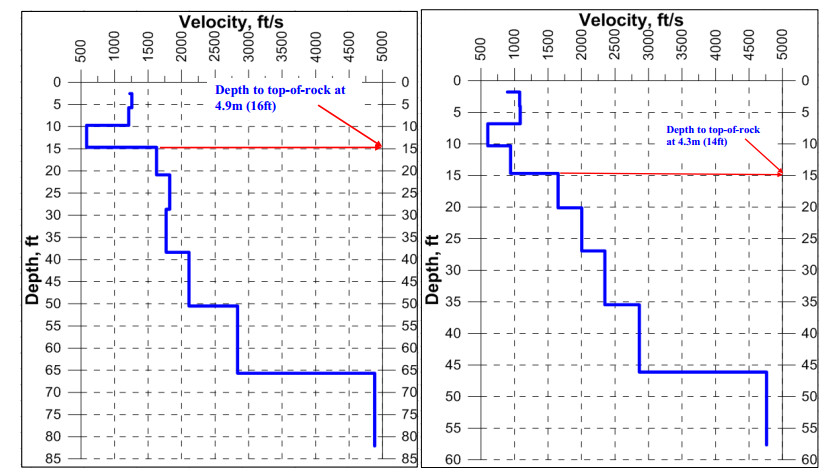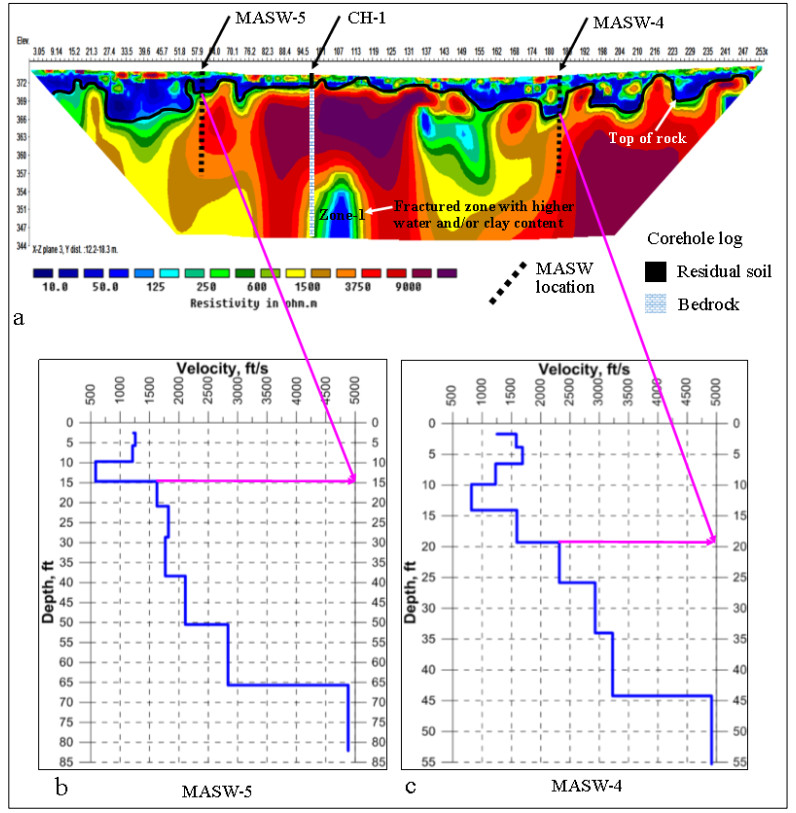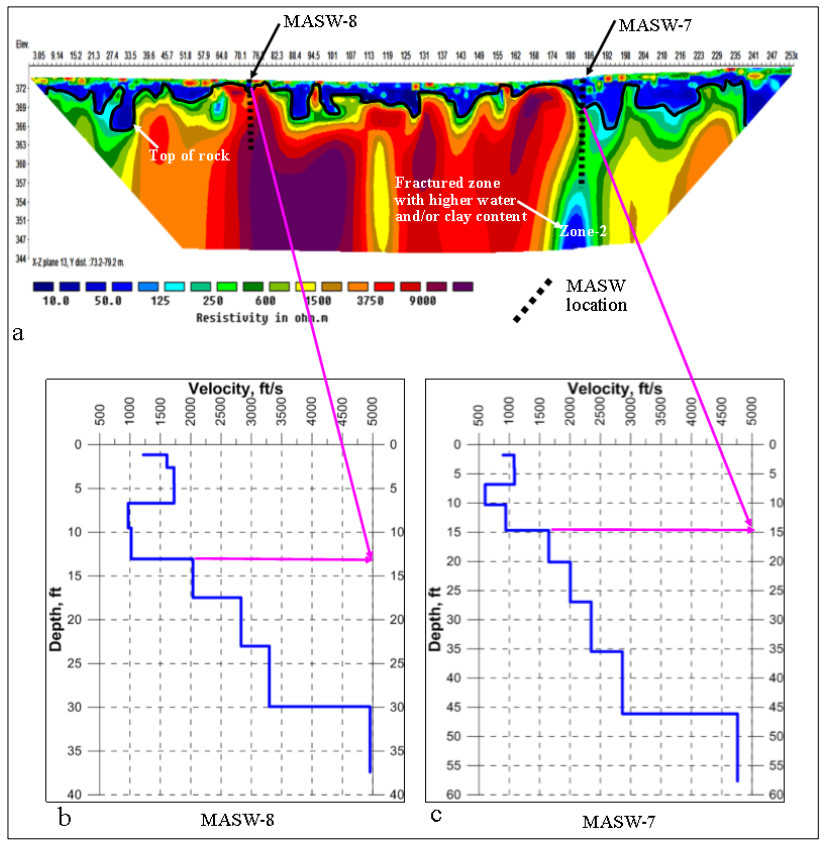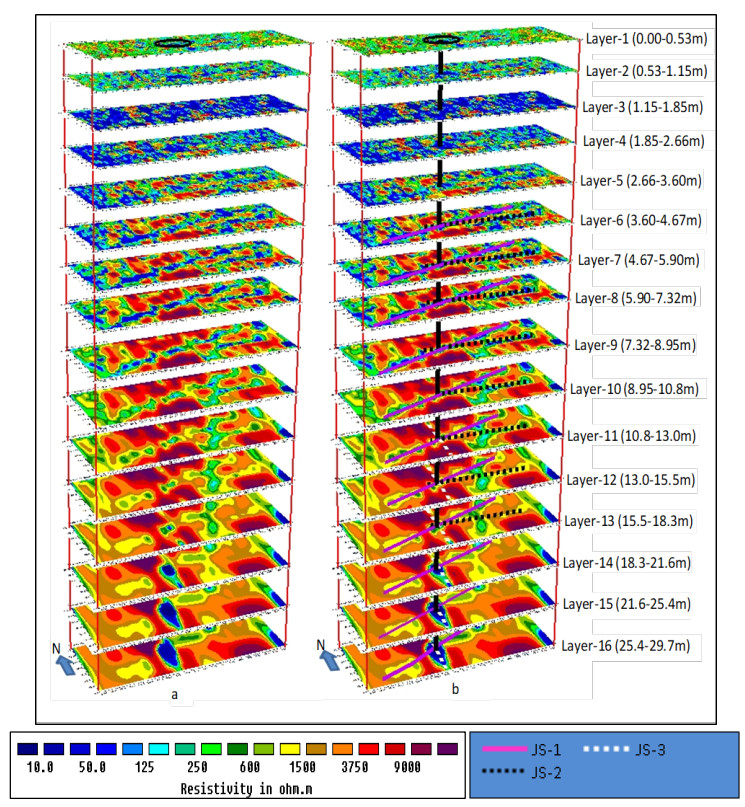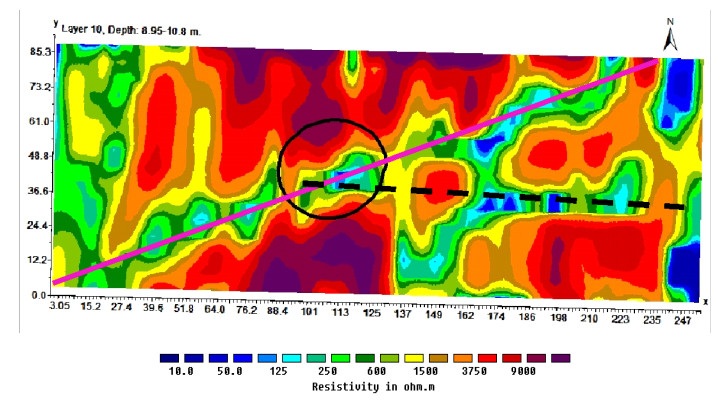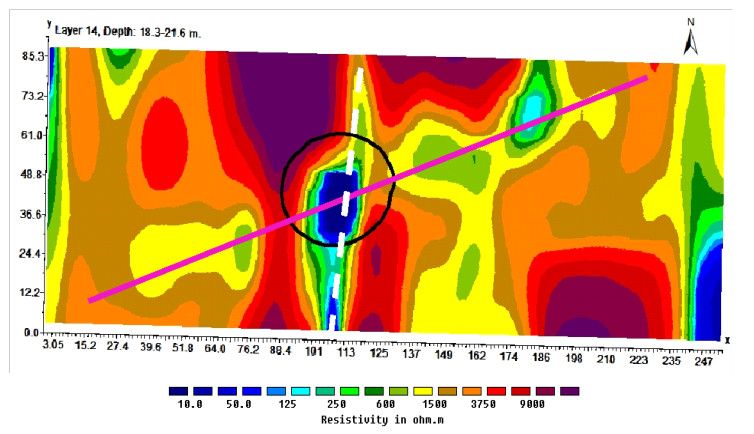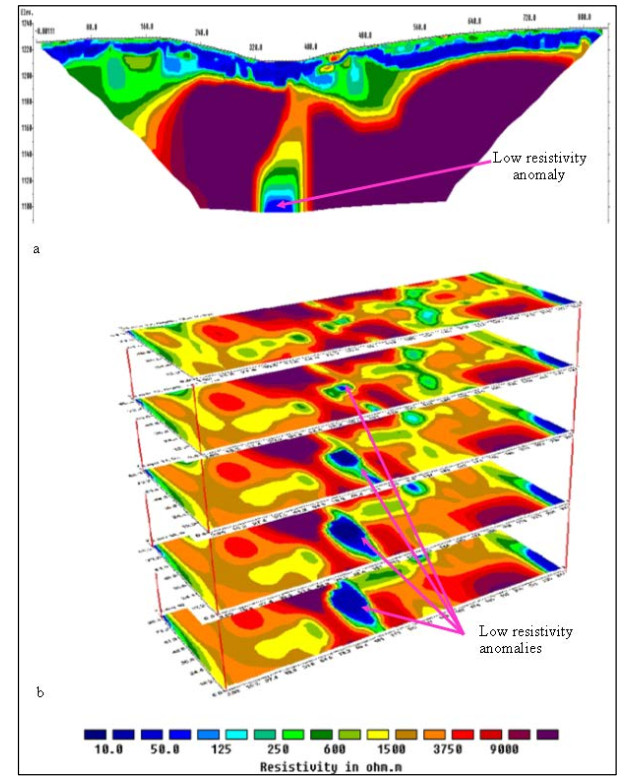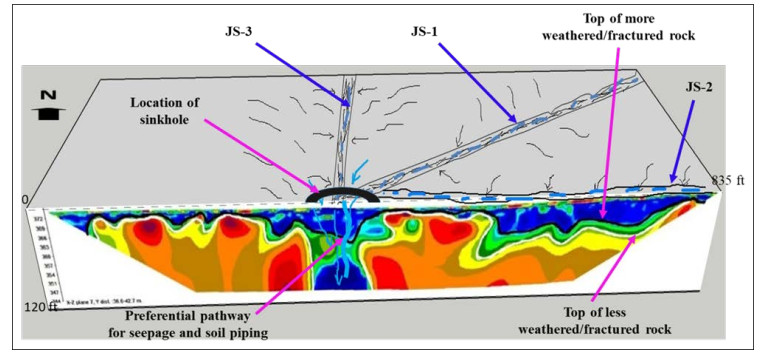Conventional 2D electrical resistivity tomography (ERT) data were acquired along 16 parallel traverses spaced at 6.1 m (20 ft) intervals across a karst sinkhole site in Greene County Missouri. The acquired ERT data were processed as both 2D data and pseudo-3D data. Based on the correlation with the available core hole control, multichannel analysis of surface waves (MASW) data and field observations, it is concluded that the subsurface structure of the sinkhole is more reliably imaged on the pseudo-3D dataset than in the 2D dataset. The interpretation results of the pseudo-3D ERT indicated that the sinkhole developed at the intersection of three vertical solution-widened joint sets.
1.
Introduction
The paper [1] by Pawlak was the first article focused on the rough area between the interior set A∘ and the closure set ¯A of a subset A in a universal set X. This idea led to many applications in decision theory. The theory of rough sets is constructed using the equivalence classes as its building blocks.
The most efficacious tools to study the generalization of rough set theory are the neighborhood systems. The main idea in this theory is the upper and lower approximations that have been defined using different types of neighborhoods instead of equivalence classes such as left and right neighborhoods [2,3,4,5], minimal left neighborhoods [6] and minimal right neighborhoods [7], and the intersection of minimal left and right neighborhoods [8]. Afterwards, the approximations by minimal right neighborhoods which are determined by reflexive relations that form the base of the topological space defined in [9]. In 2018, Dai et al. [10] presented new kind of neighborhoods, namely the maximal right neighborhoods which were determined by similarity relations and have been used to propose three new kinds of approximations. Dai et al.'s approximations [10] differed from Abo-Tabl's approximations [9] in that the corresponding upper and lower approximations, boundary regions, accuracy measures, and roughness measures in two types of Dai et al.'s approximations [10] had a monotonicity. Later on, Al-shami [11] embraced a new type of neighborhood systems namely, the intersection of maximal right and left neighborhoods, and then used this type to present new approximations. These approximations improved the accuracy measures more than Dai et al.'s approximations [10]. Al-shami's [11] accuracy measures preserved the monotonic property under any arbitrary relation. The paper [12], by Molodtsov, was the first article that defined the notion "soft set", and it has many applications in uncertainty area or ambiguity decision. A theoretical research on soft set theory was given in [13] by Maji et al. The paper [14] by Ali et al. proposed many soft set-theoretical notions such as union, intersection, difference and complement. [15,16,17,18,19,20] objected to developing the theory and the applications of soft sets. In [21], the authors introduced the soft ideal notion. It is a completely new approach for modeling vagueness and uncertainty by reducing the boundary region and increasing the accuracy of a rough set which helped scholars to solve many real-life problems [4,22,23,24,25]. Recently, many extensions of the classical rough set approximations have been applied to provide new rough paradigms using certain topological structures and concepts like subset neighborhoods, containment neighborhoods, and maximal and minimal neighborhoods to deal with rough set notions and address some real-life problems [2,4,26,27,28]. Numerous researchers have recently examined some topological concepts, including continuity, separation axioms, closure spaces, and connectedness in ideal approximation spaces [29,30,31]. Ordinary rough sets were defined using an equivalence relation R on X, and produced two approximations, one is lower and second is upper. The space (X,R) is named approximation space. In the soft case, soft roughness used soft relations [32]. Some researchers transferred the common definitions in set-topology to soft set-topology, depending on that soft topology is an extension to the usual topology as explained in [15]. Many researchers objected to the basics of set-topology and subsequently the well-known embedding theorems but in point of view of soft set-topology with some real-life applications (see [33,34,35,36,37,38]). This paper used the notion of soft binary relations to ensure that the soft interior and soft closure in approximation spaces utilizing soft ideal to generate soft ideal approximation topological spaces based on soft minimal neighborhoods. We illustrated that soft rough approximations [17] are special cases of the current soft ideal approximations. Soft accumulation points, soft exterior sets, soft dense sets, and soft nowhere dense sets with respect to these spaces were defined and studied, and we gave some examples. We introduce and study soft ideal accumulation points in such spaces under a soft ideal defined on the given soft ideal. Soft separation axioms with respect to these soft ideal approximation spaces are reformulated via soft relational concepts and compared with examples to show their implications. In addition, we reformulate and study soft connectedness in these soft ideal approximation spaces. Finally, we defined soft boundary region and soft accuracy measure with respect to our soft ideal approximation spaces. We added two real life examples to illustrate the importance of the results obtained in this paper.
This paper is divided into 6 sections beyond the introduction and the preliminaries. Section 3 defined the soft approximation spaces using a soft ideal. Section 4 is the main section of the manuscript and displays the properties of soft sets in the soft ideal approximation spaces. It has been generated using the concepts of R<x>R, soft neighborhoods and soft ideals. We study the main properties in soft ideal approximation spaces which are generalizations of the same properties of ideal approximation spaces given by Abbas et al. [31] and provide various illustrative examples. Section 5 introduced soft lower separation axioms via soft binary relations and soft ideal as a generalization of lower separation axioms given in [31]. We scrutinized its essential characterizations of some of its relationships associated with the soft ideal closure operators. Some illustrative examples are given. Section 6 reformulated and studied soft connectedness in [31] with respect to these soft ideal approximation spaces. Some examples are submitted to explain the definitions. Section 7 is devoted to comparing between the current purposed methods in Definitions 3.4–3.6 and to demonstrate that the method given in Definition 3.6 is the best in terms of developing the soft approximation operators and the values of soft accuracy. That is, the third approach in Definition 3.6 produces soft accuracy measures of soft subsets higher than their counterparts displayed in previous method 2.4 in [17]. Moreover, we applied these approaches to handle real-life problems. Section 8 is the conclusion.
2.
Preliminaries
Through this paper, X stands for the universal set of objects, E denotes the set of parameters, LE denotes for a soft ideal, RE as a soft binary relation, P(X) represents all subsets of X, and SS(X) refers to the set of all soft subsets of X. All basic notions and notations of soft sets are found in [12,13,15,39,40].
If (F,E) is a soft set of X and x∈X, then xˇ∈(F,E) whenever x∈F(e) for each e∈E. A soft set (F,E) of X with F(e)={x} for each e∈E is called a singleton soft set or a soft point and it is represented by xE or (x,E). Let (F1,E),(F2,E)ˇ∈SS(X)E. Then, (F1,E) is a soft subset of (F2,E), represented by (F1,E)⊑(F2,E), if F1(e)⊆F2(e),∀e∈E. In that case, (F1,E) is called a soft subset of (F2,E) and (F2,E) is said to be a soft supset of (F1,E), (F2,E)⊒(F1,E). Two soft subset (F1,E) and (F2,E) over X are called equal if (F1,E) is soft subset of (F2,E) and (F1,E) is soft supset of (F2,E). A soft set (F,E) over X is called a NULL soft set written as Φ if for each e∈E,F(e)=ϕ. Let A be a non-empty subset of X, then ˜AE or ˜A represents the absolute soft set (A,E) of X in which A(e)=A, for each e∈E. The soft intersection (resp. soft union) of (F1,E) and (F2,E) over X denoted by (F1⊓F2,E) (resp. (F1⊔F2,E)) and defined as (F1⊓F2)(e)=F1(e)∩F2(e) (resp. (F1⊔F2)(e)=F1(e)∪F2(e)) for each e∈E. Complementing a soft set (F,E) is represented by (F,E)c and it is defined as (F,E)c=(Fc,E) where Fc:E⟶P(X) is a mapping defined by Fc(e)=X−F(e) for all e∈E, and Fc is then a soft complement function of F.
Definition 2.1. [32] Let (R,E)=RE be a soft set of X×X, that is R:E⟶P(X×X). Then, RE is said to be a soft binary relation of X. RE is a collection of parameterized binary relations of X, from that R(e) is a binary relation on X for all parameters e∈E. The set of all soft binary relations of X is denoted by SBr(X).
Definition 2.2. [15] Let ˜τ be a collection of soft sets over a universe X with a fixed set of parameters E. Then, ˜τ⊑SS(X)E is called a soft topology on X if
(1)˜X,ΦEˇ∈˜τ,
(2) the intersection of any two soft sets in ˜τ belongs to ˜τ,
(2) the union of any number of soft sets in in ˜τ belongs to ˜τ.
The triplet (X,˜τ,E) is called a soft topological space over X.
Definition 2.3. [28] A mapping Cl:SS(X)E⟶SS(X)E is called a soft closure operator on X if it satisfies these properties for every (F,E),(G,E)ˇ∈SS(X)E:
(1) Cl(Φ)=Φ,
(2) (F,E)⊆Cl(F,E),
(3) Cl[(F,E)⊔(G,E)]=Cl(F,E)⊔Cl(G,E),
(4) Cl(Cl(F,E))=Cl(F,E).
Definition 2.4. [17] Let R:E⟶P(X1×X2) and A⊆X2. Then, the sets R_A(e),¯RA(e) could be defined by
where xR(e)={y∈X2:(x,y)∈R(e)}. Moreover, R_:E⟶P(X1) and ¯R:E⟶P(X1) and we say (X1,X2,R) a generalized soft approximation space.
Definition 2.5. [21] Let LE be a non-empty family of soft sets of X. Then, LE⊑SS(X)E is said to be a soft ideal on X if the following properties are fulfilled:
(1)Φˇ∈LE,
(2) (F,E)ˇ∈LE and (G,E)⊑(F,E) imply (G,E)ˇ∈LE,
(3) (F,E),(G,E)ˇ∈LE imply (F,E)⊔(G,E)ˇ∈LE.
3.
Soft approximation spaces via soft ideals
In this section, we define the soft approximation spaces using soft ideals.
Definition 3.1. Let RE be a soft binary relation of X and (x,y)∈X×X. Then, (x,y)ˇ∈R whenever (x,y)∈R(e) for each e∈E.
Definition 3.2. Let RE be a soft binary relation of X. Then, the soft afterset of xˇ∈˜X is xR={yˇ∈˜X:(x,y)ˇ∈R}. Also, the soft foreset of xˇ∈˜X is Rx={yˇ∈˜X:(y,x)ˇ∈R}.
Definition 3.3. Let RE be a soft binary relation over X. Then, a soft set <x>R:E⟶P(X) is defined by
Also, R<x>: E⟶P(X) is the intersection of all foresets containing x, that is,
Also, R<x>R=R<x>⊓<x>R.
Lemma 3.1. Let RE be a soft binary relation over X. Then,
(1) If xˇ∈<y>R, then <x>R⊑<y>R.
(2) If xˇ∈R<y>R, then R<x>R⊑R<y>R.
Proof. (1) Let zˇ∈<x>R=⊓xˇ∈wR(wR). Then, z is contained in any wR which contain x, and since x is contained in any uR which contains y, we have zˇ∈<y>R. Hence, <x>R⊑<y>R.
(2) Straightforward from part (1).
□
Definition 3.4. Let RE be a soft binary relation of X. For a soft set (F,E)ˇ∈SS(X)E, the soft lower approximation Apr_1S(F,E) and the soft upper approximation ¯Apr1S(F,E) are defined by:
Theorem 3.1. Let (F,E),(G,E)ˇ∈SS(X)E. The soft upper approximation defined by Eq (3.2) has the following properties:
(1) ¯Apr1S(Φ)=Φ and ¯Apr1S(˜X)=˜X,
(2) (F,E)⊆¯Apr1S(F,E),
(3) (F,E)⊑(G,E)⇒¯Apr1S(F,E)⊑¯Apr1S(G,E),
(4) ¯Apr1S[(F,E)⊓(G,E)]⊑¯Apr1S(F,E)⊓¯Apr1S(G,E),
(5) ¯Apr1S[(F,E)⊔(G,E)]=¯Apr1S(F,E)⊔¯Apr1S(G,E),
(6) ¯Apr1S(¯Apr1S(F,E))=¯Apr1S(F,E),
(7) ¯Apr1S(F,E)=[Apr_1S(F,E)c]c.
Proof. (1),(2) It is clear from Definition 3.4.
(3) Let xˇ∈¯Apr1S[(F,E). Then, <x>R⊓(F,E)≠Φ. Since (F,E)⊑(G,E), <x>R⊓(G,E)≠Φ. Therefore, xˇ∈¯Apr1S(G,E). Hence, ¯Apr1S(F,E)⊑¯Apr1S(G,E).
(4) Immediately by part (3).
(5) ¯Apr1S[(F,E)⊔(G,E)]=[(F,E)⊔(G,E)]⊔{xˇ∈˜X: <x>R⊓[(F,E)⊔(G,E)]≠Φ}. Then,
¯Apr1S[(F,E)⊔(G,E)]=[(F,E)⊔{xˇ∈˜X: <x>R⊓(F,E)≠Φ}]⊔[(G,E)⊔{xˇ∈˜X: <x>R⊓(G,E)≠Φ}]. Hence, ¯Apr1S[(F,E)⊔(G,E)]=¯Apr1S((F,E))⊔¯Apr1S((G,E)).
(6) From part (2), we have ¯Apr1S(F,E)⊑¯Apr1S(¯Apr1S(F,E)).
Conversely, let xˇ∈¯Apr1S(¯Apr1S(F,E)). Then, <x>R⊓¯Apr1S(F,E)≠Φ. Thus, there exists yˇ∈<x>R⊓¯Apr1S(F,E). That means <y>R⊑<x>R (by Lemma 3.1 part (1)) and <x>R⊓(F,E)≠Φ. Hence, xˇ∈¯Apr1S(F,E). This completes the proof.
(7)
□
Example 3.1. Let X={a,b,c,d}, E={e1,e2} and
RE={(e1,{(a,a),(a,b),(b,d),(c,d),(d,c),(d,d)),(e2,{(a,a),(a,b),(a,c),(b,d),(b,c),(c,d),(d,c),(d,d),(d,b))}}. Then, we have
<a>R=<b>R={(e1,{a,b}),(e2,{a,b})},<c>R={(e1,{c,d}),(e2,{c,d})},
<d>R={(e1,{d}),(e2,{d})}. Suppose (F1,E)={(e1,{a,c}),(e2,{a,c})} and
(F2,E)={(e1,{a,d}),(e2,{a,d})}. Therefore,
¯Apr1S(F1,E)=(F,E)⊔{xˇ∈˜X:<x>R⊓(F,E)≠Φ}={(e1,{a,b,c}),(e2,{a,b,c})}, ¯Apr1S(F2,E)=˜X and ¯Apr1S[(F1,E)⊓(F2,E)]={(e1,{a,b}),(e2,{a,b})}. Hence, ¯Apr1S[(F1,E)⊓(F2,E)]≠¯Apr1S(F1,E)⊓¯Apr1S(F2,E).
Corollary 3.1. Let RE be a soft binary relation of X. Then, the soft operator ¯Apr1S:SS(X)E⟶SS(X)E is said to be a soft closure operator and (X,¯Apr1S) is standing for a soft closure space. Moreover, it induces a soft topology on X written as ˜τ1S and defined by ˜τ1S={(F,E)ˇ∈SS(X)E:¯Apr1S(F,E)c=(F,E)c}.
Theorem 3.2. Let (F,E),(G,E)ˇ∈SS(X)E. The soft lower approximation defined by Eq (3.1) has the following properties:
(1) Apr_1S(Φ)=Φ and Apr_1S(˜X)=˜X,
(2) Apr_1S(F,E)⊑(F,E),
(3) (F,E)⊑(G,E)⇒Apr_1S(F,E)⊑Apr_1S(G,E),
(4) Apr_1S[(F,E)⊓(G,E)]=Apr_1S(F,E)⊓Apr_1S(G,E),
(5) Apr_1S[(F,E)⊔(G,E)]⊒Apr_1S(F,E)⊔Apr_1S(G,E),
(6) Apr_1S(Apr_1S(F,E))=Apr_1S(F,E),
(7) Apr_1S(F,E)=[¯Apr1S(F,E)c]c.
Proof. It is the same as given in Theorem 3.1. □
Note that the equality in Theorem 3.2 part (5) did not hold in general (see Example 3.1).
Take (F1,E)={(e1,{b,c}),(e2,{b,c})} and (F2,E)={(e1,{b,d}),(e2,{b,d})}. Then,
Apr_1S(F1,E)={xˇ∈(F1,E):<x>R⊑(F1,E)}=Φ, Apr_1S(F2,E)={(e1,{d}),(e2,{d})} and
Apr_1S[(F1,E)⊔(F2,E)]={(e1,{c,d}),(e2,{c,d})}, which means that
Apr_1S[(F,E)⊔(G,E)]≠Apr_1S(F,E)⊔Apr_1S(G,E).
Definition 3.5. Let RE be a soft binary relation over X and LE a soft ideal on X. For any soft set (F,E)ˇ∈SS(X)E, the soft lower approximation and the soft upper approximation of (F,E) by LE, denoted by Apr_2S(F,E) and ¯Apr2S(F,E) are defined by:
Theorem 3.3. Let (F,E),(G,E)ˇ∈SS(X)E. The soft upper approximation defined by Eq (3.4) has the following properties:
(1) ¯Apr2S(Φ)=Φ and ¯Apr2S(˜X)=˜X,
(2) (F,E)⊆¯Apr2S(F,E),
(3) (F,E)⊑(G,E)⇒¯Apr2S(F,E)⊑¯Apr2S(G,E),
(4) ¯Apr2S[(F,E)⊓(G,E)]⊑¯Apr2S(F,E)⊓¯Apr2S(G,E),
(5) ¯Apr2S[(F,E)⊔(G,E)]=¯Apr2S(F,E)⊔¯Apr2S(G,E),
(6) ¯Apr2S(¯Apr2S(F,E))=¯Apr2S(F,E),
(7) ¯Apr2S(F,E)=[Apr_2S(F,E)c]c.
Proof. (1),(2) Direct from Definition 3.5.
(3) Let xˇ∈¯Apr2S[(F,E). Thus, <x>R⊓(F,E)ˇ∉LE. Since (F,E)⊑(G,E) and LE is a soft ideal, <x>R⊓(G,E)ˇ∉LE. Therefore, xˇ∈¯Apr2S(G,E). Hence, ¯Apr2S(F,E)⊑¯Apr2S(G,E).
(4) Straightforward by part (3).
(5) ¯Apr2S[(F,E)⊔(G,E)]=[(F,E)⊔(G,E)]⊔{xˇ∈˜X:<x>R⊓[(F,E)⊔(G,E)]ˇ∉LE}. Then, ¯Apr2S[(F,E)⊔(G,E)]=[(F,E)⊔{xˇ∈˜X:<x>R⊓(F,E)ˇ∉LE}]⊔[(G,E)⊔{xˇ∈˜X:<x>R⊓(G,E)ˇ∉LE}]. Hence, ¯Apr2S[(F,E)⊔(G,E)]=¯Apr2S((F,E))⊔¯Apr2S((G,E)).
(6) From part (2), we have ¯Apr2S(F,E)⊑¯Apr2S(¯Apr2S(F,E)).
Conversely, let xˇ∈¯Apr2S(¯Apr2S(F,E)). Then, <x>R⊓¯Apr2S(F,E)ˇ∉LE. Therefore, <x>R⊓¯Apr1S(F,E)≠Φ. Thus, there exists yˇ∈<x>R⊓¯Apr2S(F,E). That means <y>R⊑<x>R (by Lemma 3.1 part (1)) and <y>R⊓(F,E)ˇ∉LE. Then, <x>R⊓(F,E)ˇ∉LE. Hence, xˇ∈¯Apr2S(F,E). This completes the proof.
(7)
□
Corollary 3.2. Let RE be a soft binary relation over X and LE be a soft ideal on X. Then, the soft operator ¯Apr2S:SS(X)E⟶SS(X)E is said to be a soft closure operator and (X,¯Apr2S) is standing for a soft closure space. Moreover, it induces a soft topology on X written as ˜τ2S and defined by ˜τ2S={(F,E)ˇ∈SS(X)E:¯Apr2S(F,E)c=(F,E)c}.
Theorem 3.4. Let (F,E),(G,E)ˇ∈SS(X)E. The soft lower approximation defined by Eq (3.3) has the following properties:
(1) Apr_2S(Φ)=Φ and Apr_2S(˜X)=˜X,
(2) Apr_2S(F,E)⊑(F,E),
(3) (F,E)⊑(G,E)⇒Apr_2S(F,E)⊑Apr_2S(G,E),
(4) Apr_2S[(F,E)⊓(G,E)]=Apr_2S(F,E)⊓Apr_2S(G,E),
(5) Apr_2S[(F,E)⊔(G,E)]⊒Apr_2S(F,E)⊔Apr_2S(G,E),
(6) Apr_2S(Apr_2S(F,E))=Apr_2S(F,E),
(7) Apr_2S(F,E)=[¯Apr2S(F,E)c]c.
Proof. It is similar to that was given in Theorem 3.3. □
Definition 3.6. Let RE be a soft binary relation over X and LE be a soft ideal on X. For any soft set (F,E)ˇ∈SS(X)E, the soft lower approximation and soft upper approximation of (F,E) by LE, denoted by Apr_3S(F,E) and ¯Apr3S(F,E) are defined by:
Theorem 3.5. Let (F,E),(G,E)ˇ∈SS(X)E. The soft upper approximation defined by Eq (3.6) has the following properties:
(1) ¯Apr3S(Φ)=Φ and ¯Apr3S(˜X)=˜X,
(2) (F,E)⊆¯Apr3S(F,E),
(3) (F,E)⊑(G,E)⇒¯Apr3S(F,E)⊑¯Apr3S(G,E),
(4) ¯Apr3S[(F,E)⊓(G,E)]⊑¯Apr3S(F,E)⊓¯Apr3S(G,E),
(5) ¯Apr3S[(F,E)⊔(G,E)]=¯Apr3S(F,E)⊔¯Apr3S(G,E),
(6) ¯Apr3S(¯Apr3S(F,E))=¯Apr3S(F,E),
(7) ¯Apr3S(F,E)=[Apr_3S(F,E)c]c.
Proof. It is clear from Theorem 3.3. □
Corollary 3.3. Let RE be a soft binary relation over X and LE be a soft ideal on X. Then, the soft operator ¯Apr3S:SS(X)E⟶SS(X)E is said to be a soft closure operator and (X,¯Apr3S) is standing for a soft closure space. In addition, (X,RE,LE) is said to be a soft ideal approximation space. Moreover, it induces a soft topology on X written as ˜τ3S and defined by ˜τ3S={(F,E)ˇ∈SS(X)E:¯Apr3S(F,E)c=(F,E)c}. It is clear that ˜τ1S⊑˜τ2S⊑˜τ3S.
Theorem 3.6. Let (F,E),(G,E)ˇ∈SS(X)E. The soft lower approximation defined by Eq (3.5) has the following properties:
(1) Apr_3S(Φ)=Φ and Apr_3S(˜X)=˜X,
(2) Apr_3S(F,E)⊑(F,E),
(3) (F,E)⊑(G,E)⇒Apr_3S(F,E)⊑Apr_3S(G,E),
(4) Apr_3S[(F,E)⊓(G,E)]=Apr_3S(F,E)⊓Apr_3S(G,E),
(5) Apr_3S[(F,E)⊔(G,E)]⊒Apr_3S(F,E)⊔Apr_3S(G,E),
(6) Apr_3S(Apr_3S(F,E))=Apr_3S(F,E),
(7) Apr_3S(F,E)=[¯Apr3S(F,E)c]c.
Corollary 3.4. Let RE be a soft binary relation over X, (F,E)ˇ∈SS(X)E and LE be a soft ideal on X. Then,
Proof. Direct from Definitions 3.4–3.6, using Lemma 3.1. □
4.
Properties of soft sets in the soft ideal approximation spaces
We dedicate this is the main section of the manuscript to display the properties of soft sets in the soft ideal approximation spaces. It has been generated using the concepts of R<x>R, soft neighborhoods and soft ideals. We study the main properties in soft ideal approximation spaces which are generalizations of the same properties of ideal approximation spaces given by Abbas et al. in [31] and provide various illustrative examples.
Lemma 4.1. Let (X,RE,LE) is be a soft ideal approximation space. Then,
(1) Apr_1S(<x>R)=<x>R,
(2) Apr_2S(<x>R)=<x>R,
(3) Apr_3S(R<x>R)=R<x>R.
Proof. We will ensure that item (1) and the other items will be similar. From Theorem 3.3 part (3), it is clear that Apr_2S(<x>R)⊑<x>R.
Conversely, we will ensure that <x>R⊑Apr_2S(<x>R). Let yˇ∈<x>R. Then, by Lemma 3.1 part(1), <y>R⊑<x>R. Thus, <y>R⊓(<x>R)c=Φ. So, <y>R⊓(<x>R)cˇ∈LE. Hence, yˇ∈Apr_2S(<x>R). Thus, <x>R⊑Apr_2S(<x>R). □
Proposition 4.1. Let (X,RE,LE) be a soft ideal approximation space. For x≠yˇ∈˜X,
(1) xˇ∈¯Apr1S(yE) iff <x>R⊓yE≠Φ and xˇ∉¯Apr1S(yE) iff <x>R⊓yE=Φ,
(2) xˇ∈¯Apr2S(yE) iff <x>R⊓yEˇ∉LE and xˇ∉¯Apr2S(yE) iff <x>R⊓yEˇ∈LE,
(3) xˇ∈¯Apr3S(yE) iff R<x>R⊓yEˇ∉LE and xˇ∉¯Apr3S(yE) iff R<x>R⊓yEˇ∈LE.
Proof. We will prove the second statement and the others will be similar. Let xˇ∈¯Apr2S(yE). Then,
xˇ∈[yE⊔{zˇ∈˜X: <z>R⊓yEˇ∉LE}]. Thus, <x>R⊓yEˇ∉LE. Conversely, let <x>R⊓yEˇ∉LE. Then, by Definition 3.6, xˇ∈¯Apr2S(yE). □
Proposition 4.2. Let (X,RE,LE) be a soft ideal approximation space and <x>Rˇ∈LE. Then,
(1) Apr_1S(xE)=xE=¯Apr1S(xE),
(2) Apr_2S(xE)=xE=¯Apr2S(xE),
(3) Apr_3S(xE)=xE=¯Apr3S(xE).
Proof. We will prove that the second statement and the others will be similar. Let <x>Rˇ∈LE. Then, <x>R⊓[xE]cˇ∈LE. Thus, xˇ∈Apr_2S(xE). So, Apr_2S(xE)=xE. Also, <x>Rˇ∈LE induces that <x>R⊓yEˇ∈LE for all yˇ∈X. Hence, ¯Apr2S(xE)=xE. □
Theorem 4.1. Let (X,RE,LE) be a soft ideal approximation space and xˇ∈˜X,(F,E)ˇ∈SS(X)E.
If <x>R⊓(F,E)ˇ∈LE, then
(1) <x>R⊓¯Apr1S(F,E)=Φ,
(2) <x>R⊓¯Apr2S(F,E)ˇ∈LE,
(3) R<x>R⊓¯Apr3S(F,E)ˇ∈LE.
Proof. We will prove the second part and the others will be similar. Suppose <x>R⊓(F,E)ˇ∈LE. It is clear that [<x>R−xE]⊓(F,E)ˇ∈LE. Then, xˇ∉D∗S(F,E). Thus, <x>R⊓D∗S(F,E)=Φ. So,
<x>R⊓D∗S(F,E)ˇ∈LE. Hence, [<x>R⊓(F,E)⊔D∗S(F,E)]ˇ∈LE. Therefore,
<x>R⊓¯Apr2S(F,E)ˇ∈LE. □
Definition 4.1. Let (X,RE,LE) be a soft ideal approximation space and (F,E)ˇ∈SS(X)E. The soft exterior of (F,E) is ExtiS(F,E)=Apr_iS(F,E)c, i∈{1,2,3}.
Lemma 4.2. Let (X,RE,LE) be a soft ideal approximation space and (F,E),(G,E)ˇ∈SS(X)E. For i∈{1,2,3}, we have
(1) ExtiS(Φ)=˜X and ExtiS(˜X)=Φ,
(2) ExtiS(F,E)⊑(F,E)c,
(3) (F,E)⊑(G,E)⇒ExtiS(F,E)⊑ExtiS(G,E),
(4) ExtiS[(F,E)⊔(G,E)]=ExtiS(G,E)⊓ExtiS(F,E),
(5) Apr_iS(F,E)=ExtiS[ExtiS(F,E)],
(6) ExtiS(F,E)=ExtiS([ExtiS(F,E)]c).
Proof. Straightforward from Theorems 3.2, 3.4, and 3.6. □
Definition 4.2. Let (X,RE,LE) be a soft ideal approximation space and (F,E)ˇ∈SS(X)E. Then, a soft point xEˇ∈SS(X)E is called:
(i) A soft accumulation point of (F,E) if (<x>R−xE)⊓(F,E)≠Φ.
The set of all soft ideal accumulation points of (F,E) is written as DS(F,E), that is,
(ii) A ∗-soft ideal accumulation point of (F,E) if (<x>R−xE)⊓(F,E)ˇ∉LE.
The set of all ∗-soft ideal accumulation points of (F,E) is written as D∗S(F,E), that is,
(iii) A ∗∗-soft ideal accumulation point of (F,E) if (R<x>R−xE)⊓(F,E)ˇ∉LE.
The set of all ∗∗-soft ideal accumulation points of (F,E) is written as D∗∗S(F,E), that is,
Lemma 4.3. Let (X,RE,LE) be a soft ideal approximation space and (F,E)ˇ∈SS(X)E. Then,
(1) ¯Apr1S(F,E)=(F,E)⊔DS(F,E),
(2) ¯Apr1S(F,E)=(F,E) iff DS(F,E)⊑(F,E),
(3) ¯Apr2S(F,E)=(F,E)⊔D∗S(F,E),
(4) ¯Apr2S(F,E)=(F,E) iff D∗S(F,E)⊑(F,E),
(5) ¯Apr3S(F,E)=(F,E)⊔D∗∗S(F,E),
(6) ¯Apr3S(F,E)=(F,E) iff D∗∗S(F,E)⊑(F,E).
Proof. We will prove that the third and forth statements and the others will be similar.
(3) Let xˇ∈¯Apr2S(F,E). Then, xˇ∈[(F,E)⊔{yEˇ∈SS(X)E : <y>R⊓(F,E)ˇ∉LE}]. Then, we have either xˇ∈(F,E), that is,
or xˇ∉(F,E). So, xˇ∈{yEˇ∈SS(X)E:<y>R⊓(F,E)ˇ∉LE}. In the latter case, we have (<x>R−xE)⊓(F,E)ˇ∉LE. Hence, xˇ∈D∗S(F,E), that is,
From Eqs (4.1) and (4.2), ¯Apr2S(F,E)⊑(F,E)⊔D∗S(F,E). Conversely, let xˇ∈(F,E)⊔D∗S(F,E). Then, we have either xˇ∈(F,E), that is,
or xˇ∉(F,E). Thus, xˇ∈D∗S(F,E). So (<x>R−xE)⊓(F,E)ˇ∉LE. Hence, xˇ∈¯Apr2S(F,E), that is,
From Eqs (4.3) and (4.4), (F,E)⊔D∗S(F,E)⊑¯Apr2S(F,E).
Therefore, ¯Apr2S(F,E)=(F,E)⊔D∗S(F,E).
(4) Let xˇ∉(F,E), that is, xˇ∉¯Apr2S(F,E). Then, <x>R⊓(F,E)ˇ∈LE. Thus,
(<x>R−xE)⊓(F,E)ˇ∈LE and xˇ∉D∗S(F,E). Conversely, let D∗S(F,E)⊑(F,E). Then, by part (1), D∗S(F,E)⊔(F,E)=¯Apr2S(F,E)=(F,E).
□
Lemma 4.4. Let (X,RE,LE) be a soft ideal approximation space and (F,E),(G,E)ˇ∈SS(X)E. Then,
(1) if (F,E)⊑(G,E), then D∗S(F,E)⊑D∗S(G,E) and D∗∗S(F,E)⊑D∗∗S(G,E),
(2) D∗S[(F,E)⊔(G,E)]=D∗S(F,E)⊔D∗S(F,E) and D∗∗S[(F,E)⊔(G,E)]=D∗∗S(F,E)⊔D∗∗S(F,E),
(3) D∗S[(F,E)⊓(G,E)]⊑D∗S(F,E)⊓D∗S(F,E) and D∗∗S[(F,E)⊓(G,E)]⊑D∗∗S(F,E)⊓D∗∗S(F,E),
(4) D∗S[(F,E)⊔D∗S(F,E)]⊑(F,E)⊔D∗S(F,E) and D∗∗S[(F,E)⊔D∗∗S(F,E)]⊑(F,E)⊔D∗∗S(F,E).
Proof. (1) Suppose (F,E)⊑(G,E) and let xˇ∈D∗S(F,E). Then, [<x>R−xE]⊓(F,E)ˇ∉LE. Thus, [<x>R−xE]⊓(G,E)ˇ∉LE. So, xˇ∈D∗S(G,E). The second part is easily proved.
(2) Since (F,E)⊑(F,E)⊔(G,E) and (G,E)⊑(F,E)⊔(G,E), by part (1), we have D∗S(F,E)⊔D∗S(G,E)⊑D∗S(F,E)⊔(G,E)).
Conversely, let xˇ∉(D∗S(F,E)⊔D∗S(G,E). Then, xˇ∉D∗S(F,E) and xˇ∉D∗S(G,E). Thus, (<x>R−xE)⊓(F,E)ˇ∈LE and (<x>R−xE)⊓(G,E)ˇ∈LE. So, (<x>R−xE)⊓(F,E)⊔(G,E))ˇ∈LE. Hence, xˇ∈D∗S[(F,E)⊔(G,E)]. The proof of the second part is similar.
(3) Similar to part (2).
(4) Let xˇ∉(F,E)⊔D∗S(F,E). It is obvious that xˇ∉(F,E) and (<x>R−xE)⊓(F,E)ˇ∈LE. Then, <x>R⊓(F,E)ˇ∈LE. Thus, xˇ∉¯Apr2S(F,E). So, xˇ∉¯Apr2S(¯Apr2S(F,E)). Hence, xˇ∉D∗S(¯Apr2S(F,E))=D∗S(F,E)⊔D∗S(F,E)). Therefore, D∗S(F,E)⊔D∗S(F,E)⊑(F,E)⊔D∗S(F,E). The proof of the second part is similar. □
Corollary 4.1. Let (X,RE,LE) be any soft ideal approximation space and (F,E)ˇ∈SS(X)E. Then,
Proof. Let xˇ∉DS(F,E). Then, (<x>R−xE)⊓(F,E)=Φ. Thus, (<x>R−xE)⊓(F,E)ˇ∈LE. So, xˇ∉D∗S(F,E) and (R<x>R−xE)⊓(F,E)ˇ∈LE, where R<x>R⊑<x>R. Hence, xˇ∉D∗∗S(F,E). Therefore, D∗∗S(F,E)⊑D∗S(F,E)⊑DS(F,E). □
Remark 4.1. The converse of the previous result is not true.
Example 4.1. Let X={a,b,c} associated with a set of parameters E={e1,e2}. Let RE be a soft relation of X and LE be a soft ideal on X, defined respectively by:
LE={Φ,(F1,E),(F2,E),(F3,E)} where,
Then, <a>R={(e1,{a,b,c}),(e2,{a,b,c})},<b>R={(e1,{b,c}),(e2,{b,c})},
<c>R=cE. Also, R<a>=aE,R<b>={(e1,{a,b}),(e2,{a,b})},R<c>=<a>R. Thus, R<a>R=aE,R<b>R=bE,R<c>R=cE. Suppose (F,E)={(e1,{b,c}),(e2,{b,c})}. Then, we have:
Thus, aˇ∈DS(F,E),bˇ∈DS(F,E),cˇ∉DS(F,E). So, DS(F,E)={(e1,{a,b}),(e2,{a,b})}. On the other hand, we get:
Thus, aˇ∈D∗S(F,E),bˇ∉D∗S(F,E),cˇ∉D∗S(F,E). Hence, D∗S(F,E)=aE. Also, we have:
Then, aˇ∉D∗∗S(F,E),bˇ∉D∗∗S(F,E),cˇ∉D∗∗S(F,E). Thus, D∗∗S(F,E)=Φ. So, DS(F,E)⋢D∗S(F,E)⋢D∗∗S(F,E).
Definition 4.3. Let (X,RE,LE) be any soft ideal approximation space and (F,E)ˇ∈SS(X)E. Then, (F,E) is said to be:
(i) soft dense if ¯Apr1S(F,E)=˜X,
(ii) ∗-soft ideal dense if ¯Apr2S(F,E)=˜X,
(iii) ∗∗-soft ideal dense if ¯Apr3S(F,E)=˜X,
(iv) soft nowhere dense if Apr_1S(¯Apr1S(F,E))=Φ,
(v) ∗-soft ideal nowhere dense if Apr_1S(¯Apr2S(F,E))=Φ,
(vi) ∗∗-soft ideal nowhere dense if Apr_1S(¯Apr3S(F,E))=Φ.
Corollary 4.2. Let (X,RE,LE) be any soft ideal approximation space and (F,E)ˇ∈SS(X)E. Then,
(1) ∗∗-soft ideal dense ⟹∗-soft ideal dense ⟹ soft dense,
(2) soft nowhere dense ⟹∗-soft ideal nowhere dense ⟹∗∗-soft ideal nowhere dense.
Proof. Immediately from Definition 4.3 and part (3) of Theorem 3.5. □
Example 4.2. Let X={a,b,c}, E={e1,e2},
RE={(e1,{(a,a),(a,b),(b,b),(b,c),(c,c),(d,d),(d,b)),(e2,{(a,a),(a,b),(a,c),(b,b),(b,c),(c,c),(d,d),(d,b))}} and LE={Φ,(F1,E),(F2,E),(F3,E)}, where
(F1,E)={(e1,{a}),(e2,ϕ)},(F2,E)={(e1,ϕ),(e2,{a})},(F3,E)={(e1,{a}),(e2,{a})}.
Therefore, we have <a>R={(e1,{a,b}),(e2,{a,b})},<b>R={(e1,{b}),(e2,{b})},<c>R={(e1,{c}),(e2,{c})},<d>R={(e1,{b,d}),(e2,{b,d})}. Also, R<a>={(e1,{a}),(e2,{a})},R<b>={(e1,{b}),(e2,{b})},R<c>={(e1,{b,c}),(e2,{b,c})}R<d>={(e1,{d}),(e2,{d})}. Thus, R<a>R={(e1,{a}),(e2,{a})},R<b>R={(e1,{b}),(e2,{b})},R<c>R={(e1,{c}),(e2,{c})}R<d>R={(e1,{d}),(e2,{d})}. Suppose (F,E)={(e1,{b,c}),(e2,{b,c})}. Then, ¯Apr2S(F,E)=(F,E)⊔{xˇ∈˜X:<x>R⊓(F,E)ˇ∉LE}=˜X. Also, ¯Apr3S(F,E)=(F,E)⊔{xˇ∈˜X:R<x>R⊓(F,E)ˇ∉LE}=(F,E)≠˜X. Hence, (F,E) is ∗-soft ideal dense but not ∗∗-soft ideal dense.
Corollary 4.3. Let (X,RE,LE) be any soft ideal approximation space and (F,E)ˇ∈SS(X)E. Then,
(1) If (F,E) is soft dense, then [¯Apr1S(F,E)]c is soft nowhere dense.
(2) If (F,E) is ∗-soft ideal dense, then [¯Apr2S(F,E)]c is ∗-soft ideal nowhere dense.
(3) If (F,E) is ∗∗-soft ideal dense, then [¯Apr3S(F,E)]c is ∗∗-nowhere dense.
Proof. (1) Suppose (F,E) is soft dense. Then, ¯Apr1S(F,E)=˜X. Thus, [¯Apr1S(F,E)]c=Φ and
¯Apr1S[(¯Apr1S(F,E))c]=Φ. So, Apr_1S[¯Apr1S(¯Apr1S(F,E))c)]=Φ. Hence,
[¯Apr1S(F,E)]c is nowhere soft dense.
(2) Suppose (F,E) is ∗-soft ideal dense. Then, ¯Apr2S(F,E)=˜X. Thus, [¯Apr2S(F,E)]c=Φ. So,
¯Apr2S[(¯Apr2S(F,E))c]=Φ and Apr_1S[¯Apr2S((¯Apr2S(F,E))c)]=Φ. Hence,
[¯Apr2S(F,E)]c is ∗-soft ideal nowhere dense.
(3) Similar to part (2).
□
5.
Lower soft separation axioms in soft ideal approximation spaces
In this section, we introduce soft lower separation axioms via soft binary relations and soft ideal as a generalization of lower separation axioms given in [31]. We scrutinize its essential characterizations and infer some of its relationships associated with the soft ideal closure operators. Some illustrative examples are given. In an approximation space (X,R) where R is an equivalence relation on X, a general topology is generated by the lower approximations L(A) or the upper approximations U(A) of any subset as follows. τR={A⊆X: A=L(A)} or τR={A⊆X: Ac=U(Ac)}. In the soft case, it is an extension of the same definitions.
Definition 5.1. (1) A soft approximation space (X,RE) is said to be a soft-T0 space if ∀x≠yˇ∈˜X, there exists (F,E)ˇ∈SS(X)E such that
(2) A soft ideal approximation space (X,RE,LE) is said to be a soft-T∗0 space if ∀x≠yˇ∈˜X, there exists (F,E)ˇ∈SS(X)E such that
(3) A soft ideal approximation space (X,RE,LE) is said to be a soft-T∗∗0 space if ∀x≠yˇ∈˜X, there exists (F,E)ˇ∈SS(X)E such that
Proposition 5.1. For a soft ideal approximation space (X,RE,LE), these properties are equivalent:
(1) ˜X is a soft-T∗0 space.
(2) ¯Apr2S(xE)≠¯Apr2S(yE) for all x≠yˇ∈˜X.
Proof.
(1)⇒(2): For each x≠yˇ∈˜X, by part (1), there exists (F,E)ˇ∈SS(X)E such that xˇ∈Apr_2S(F,E), yˇ∉(F,E). Thus, <x>R⊓(F,E)cˇ∈LE, yˇ∈(F,E)c. So, <x>R⊓yEˇ∈LE and by Proposition 4.1 part (1), xˇ∉¯Apr2S(yE). Similarly, we can prove that yˇ∉¯Apr2S(xE). Therefore, ¯Apr2S(xE)≠¯Apr2S(yE).
(2)⇒(1): Suppose part (2) holds and let x≠yˇ∈˜X. Then, xˇ∉¯Apr2S(yE) or yˇ∉¯Apr2S(xE). By Proposition 4.1 part (2), <x>R⊓yEˇ∈LE or <y>R⊓xEˇ∈LE. Thus, [xˇ∈Apr_2S(yE)c,yˇ∉(yE)c] or [yˇ∈Apr_2S(xE)c,xˇ∉(xE)c]. Therefore, ˜X is soft-T∗0 space.
□
Corollary 5.1. For a soft approximation space (X,RE), these properties are equivalent:
(1)˜X is a soft-T0 space.
(2)¯Apr1S(xE)≠¯Apr1S(yE) for each x≠yˇ∈˜X.
Corollary 5.2. For a soft ideal approximation space (X,RE,LE), these properties are equivalent:
(1) ˜X is a soft-T∗∗0 space.
(2) ¯Apr3S(xE)≠¯Apr3S(yE) for all x≠yˇ∈˜X.
Definition 5.2. (1) A soft approximation space (X,RE) is said to be a soft-T1 space if ∀x≠yˇ∈˜X, there exist (F,E),(G,E)ˇ∈SS(X)E such that
(2) A soft ideal approximation space (X,RE,LE) is said to be a soft-T∗1 space if ∀x≠yˇ∈˜X, there exist (F,E),(G,E)ˇ∈SS(X)E such that
(3) A soft ideal approximation space (X,RE,LE) is said to be a soft-T∗∗1 space if ∀x≠yˇ∈˜X, there exist (F,E),(G,E)ˇ∈SS(X)E such that
Proposition 5.2. For a soft ideal approximation space (X,RE,LE), these properties are equivalent:
(1) ˜X is a soft-T∗1 space.
(2) ¯Apr2S(xE)=xE for all xˇ∈˜X.
(3) D∗S(xE)=Φ for each xˇ∈˜X.
Proof. (1) ⇒(2): Suppose (X,RE,LE) is a soft-T∗1 space and let xˇ∈˜X. Thus, for yˇ∈˜X−xE,x≠y and ∃(F,E)ˇ∈SS(X)E such that yˇ∈Apr_2S(F,E),xˇ∉(F,E). Thus, <y>R⊓(F,E)cˇ∈LE,xˇ∈(F,E)c. So, <y>R⊓xEˇ∈LE, that is, yˇ∉¯Apr2S(xE). Hence, ¯Apr2S(xE)=xE.
(2) ⇒(3): Suppose part (2) holds and let xˇ∈˜X. Then, ¯Apr2S(xE)=xE⊔D∗SxE but xˇ∉D∗SxE. Thus, D∗SxE=Φ.
(3) ⇒(1): Suppose part (3) holds and x≠yˇ∈˜X. By part (3), D∗SxE=D∗SyE=Φ. Thus, ¯Apr2S(xE)=xE and ¯Apr2S(yE)=yE, that is, Apr_2S(xE)c=(xE)c and Apr_2S(yE)c=(yE)c. So, there exist (xE)c and (yE)cˇ∈SS(X)E such that yˇ∈Apr_2S(xE)c,xˇ∉(xE)candxˇ∈Apr_2S(yE)c,yˇ∉(yE)c. Therefore, ˜X is a soft-T∗1 space.
□
Corollary 5.3. For a soft approximation space (X,RE), these properties are equivalent:
(1) ˜X is a soft-T1 space.
(2) ¯Apr1S(xE)=xE for all xˇ∈˜X.
(3) DS(xE)=Φ for each xˇ∈˜X.
Corollary 5.4. For a soft ideal approximation space (X,RE,LE), these properties are equivalent:
(1) ˜X is a soft-T∗∗1 space.
(2) ¯Apr3S(xE)=xE for all xˇ∈˜X.
(3) D∗∗S(xE)=Φ for each xˇ∈˜X.
Definition 5.3. (1) A soft approximation space (X,RE) is said to be a soft-R0 space if,
for all x≠yˇ∈˜X,
(2) A soft ideal approximation space (X,RE,LE) is said to be a soft-R∗0 space if, for all x≠yˇ∈˜X,
(3) A soft ideal approximation space (X,RE,LE) is said to be a soft-R∗∗0 space if, for all x≠yˇ∈˜X,
Proposition 5.3. For a soft ideal approximation space (X,RE,LE), these properties are equivalent:
(1) ˜X is a soft-R∗0 space,
(2) if xˇ∈¯Apr2S(yE), then yˇ∈¯Apr2S(xE) for all x≠yˇ∈˜X.
Proof.
(1) ⇒(2): Suppose statement (1) holds, and let x≠y be two soft points in (X,RE,LE). Then, ¯Apr2S(xE)=¯Apr2S(yE) or ¯Apr2S(xE)⊓¯Apr2S(yE)=Φ.
If ¯Apr2S(xE)=¯Apr2S(yE), then yˇ∈¯Apr2S(xE) and xˇ∈¯Apr2S(yE).
If ¯Apr2S(xE)⊓¯Apr2S(yE)=Φ, then xE⊓¯Apr2S(yE)=Φ and yE⊓¯Apr2S(xE)=Φ. Thus, xˇ∉¯Apr2S(yE) and yˇ∉¯Apr2S(xE)). So, xˇ∉¯Apr2S(yE) and yˇ∉¯Apr2S(xE). Hence, in either case, statement (2) holds.
(2) ⇒(1): Suppose that statement (2) holds and let x≠yˇ∈˜X. Then, we have
If xˇ∈¯Apr2S(yE)andyˇ∈¯Apr2S(xE), then
If xˇ∉¯Apr2S(yE)andyˇ∉¯Apr2S(xE), then
From (5.1) and (5.2), the proof is complete. □
Corollary 5.5. For a soft approximation space (X,RE), these properties are equivalent:
(1) ˜X is a soft-R0 space,
(2) if xˇ∈<y>R, then yˇ∈<x>R for any x≠yˇ∈˜X.
Corollary 5.6. For a soft ideal approximation space (X,RE,LE), these properties are equivalent:
(1) ˜X is a soft-R∗∗0 space,
(2) if xˇ∈¯Apr3S(yE), then yˇ∈¯Apr3S(xE) for all x≠yˇ∈˜X.
Definition 5.4. (1) A soft approximation space (X,RE) is said to be a soft-T2 space if ∀x≠yˇ∈˜X, there exist (F,E),(G,E)ˇ∈SS(X)E such that
(2) A soft ideal approximation space (X,RE,LE) is said to be a soft-T∗2 space if ∀x≠yˇ∈˜X, there exist (F,E),(G,E)ˇ∈SS(X)E such that
(3) A soft ideal approximation space (X,RE,LE) is said to be a soft-T∗∗2 space if ∀x≠yˇ∈˜X, there exist (F,E),(G,E)ˇ∈SS(X)E such that
Theorem 5.1. For a soft ideal approximation space (X,RE,LE), these properties are equivalent:
(1) ˜X is a soft-T∗2 space,
(2) ∃(F,E)ˇ∈SS(X)E:xˇ∈Apr_2S(F,E),yˇ∈[¯Apr2S(F,E)]c for any x≠yˇ∈˜X.
Proof. (1) ⇒(2): Suppose ˜X is a soft-T∗2 space and let x≠yˇ∈˜X. Then, there exist
(F,E),(G,E)ˇ∈SS(X)E such that xˇ∈Apr_2S(F,E),yˇ∈Apr_2S(G,E) and (F,E)⊓(G,E)=Φ. Thus, <y>R⊓(G,E)cˇ∈LE and (F,E)⊑(G,E)c. So [<y>R−xE]⊓(F,E)ˇ∈LE, that is, yˇ∉D∗S(F,E). Hence, Apr_2S(G,E)⊓D∗S(F,E)=Φ and Apr_2S(G,E)⊓(F,E)=Φ, that is, Apr_2S(G,E)⊓¯Apr2S(F,E)=Φ. Therefore, xˇ∈Apr_2S(F,E),yˇ∈Apr_2S(G,E)⊑[¯Apr2S(F,E)]c.
(2) ⇒(1): Suppose part (2) holds and let x≠yˇ∈˜X. Then, there exists (F,E)ˇ∈SS(X)E such that xˇ∈Apr_2S(F,E),yˇ∈[¯Apr2S(F,E)]c. Let (G,E)=[¯Apr2S(F,E)]c. Then, (G,E)=Apr_2S(F,E)c (from Theorem 3.3 part (7)) and so Apr_2S(G,E)=Apr_2S[Apr_2S(F,E)c]=Apr_2S(F,E)c=(G,E). Also, (F,E)⊓(G,E)=(F,E)⊓Apr_2S(F,E)c⊑(F,E)⊓(F,E)c=Φ. Hence, ˜X is a soft-T∗2 space.
□
Corollary 5.7. For a soft approximation space (X,RE), these properties are equivalent:
(1) ˜X is a soft-T2 space,
(2) ∃(F,E)ˇ∈SS(X)E:xˇ∈Apr_1S(F,E),yˇ∈[¯Apr1S(F,E)]c for all x≠yˇ∈˜X.
Corollary 5.8. For a soft ideal approximation space (X,RE,LE), these properties are equivalent:
(1) ˜X is a soft-T∗∗2 space,
(2) ∃(F,E)ˇ∈SS(X)E:xˇ∈Apr_3S(F,E),yˇ∈[¯Apr3S(F,E)]c for all x≠yˇ∈˜X.
Corollary 5.9. For a soft ideal approximation space (X,RE,LE), these conditions hold:
(1) soft-T1 = soft-R0 + soft-T0,
(2) soft-T∗1 = soft-R∗0 + soft-T∗0,
(3) soft-T∗∗1 = soft-R∗∗0 + soft-T∗∗0.
Proof. Straightforward from Definition 5.3, Propositions 5.1 and 5.2, and Corollaries 5.1–5.4. □
Remark 5.1. From Definitions 5.1, 5.2, and 5.4 we have the following implication.
Example 5.1 (1) Let X=Z with E={e1,e2} and R:E⟶P(Z×Z) be a soft relation over Z×Z defined by R(e1)=Z×Z, R(e2)=N×N and LE={(F,E)ˇ∈SS(X)E:(F,E) is a finite soft set}. Thus,
Thus, ∀x≠yˇ∈˜Z, we have:
So, ˜Z is a soft-T1 space. But ˜Z is not a soft-T2 space, since if xˇ∈Apr_1S(F,E),yˇ∈Apr_1S(G,E) and (F,E)⊓(G,E)=Φ, then Apr_1S(F,E)⊓Apr_1S(G,E)=Φ and Apr_1S(F,E)⊑[Apr_1S(G,E)]c which is impossible because Apr_1S(F,E) is infinite soft set and [Apr_1S(G,E)]c is finite soft set.
(2) From part (1), we have
Then, ∀x≠yˇ∈˜Z, we have:
Hence, ˜Z is soft-T∗1 and soft-T∗∗1. However, ˜Z is neither soft-T∗2 space nor soft-T∗∗2. By the same way, any one can add examples to show that the above implication is not reversible.
Definition 5.5. Let (X,RE) and (Y,(R2)H) be two soft approximation spaces and let LE a soft ideal on X. Then,
(1) a function fρϱ:SS(X)E⟶SS(Y)H is said to be soft continuous if (Apr_1S)E[f−1ρϱ(G,H)]⊒f−1ρϱ[(Apr_1S)H(G,H)], that is, (¯Apr1S)E[f−1ρϱ(G,H)]⊑f−1ρϱ[(¯Apr1S)H(G,H)] for all (G,H)ˇ∈SS(Y)H.
(2) A function fρϱ:SS(X)E⟶SS(Y)H is said to be ∗-soft continuous if (Apr_2S)E[f−1ρϱ(G,H)]⊒f−1ρϱ[(Apr_1S)H(G,H)], that is, (¯Apr2S)E[f−1ρϱ(G,H)]⊑f−1ρϱ[(¯Apr1S)H(G,H)] for all (G,H)ˇ∈SS(Y)H.
(1) A function fρϱ:SS(X)E⟶SS(Y)H is said to be ∗∗-soft continuous if (Apr_3S)E[f−1ρϱ(G,H)]⊒f−1ρϱ[(Apr_1S)H(G,H)], that is, (¯Apr3S)E[f−1ρϱ(G,H)]⊑f−1ρϱ[(¯Apr1S)H(G,H)] for all (G,H)ˇ∈SS(Y)H.
Remark 5.2. From Corollary 3.4, we have the following implications:
Example 5.2. Let X={a,b,c} associated with the parameters E={e1,e2}. Let (R1)E be a soft relation of X, and LE be a soft ideal on X, defined respectively by:
LE={Φ,(F1,E),(F2,E),(F3,E),(F4,E),(F5,E),(F6,E),(F7,E),(F8,E),(F9,E),(F10,E),(F11,E),(F12,E),(F13,E),(F14,E)(F15,E)}
where
Then, <a>R1={(e1,{a,b,c}),(e2,{a,b,c})},<b>R1={(e1,{b,c}),(e2,{b,c})}=<c>R1. Also, R1<a>=aE,R1<b>={(e1,{a,b}),(e2,{a,b})},R1<c>=Φ. Thus, R1<a>R1=aE,R1<b>R1=bE,R1<c>R1=Φ. On the other hand, let Y={u,v,w} associated with the parameters H={h1,h2}. Let (R2)H be a soft relation over Y defined by:
(R2)H={(h1,{(u,u),(u,v),(v,u),(v,v),(v,w),(w,u),(w,w)}),(h2,{(u,u),(u,v),(v,u),(v,v),
(w,w)})}. Then, <u>R2={(h1,{u,v}),(h2,{u,v})}=<v>R2,<w>R2=wH. Also, R2<u>={(h1,{u,v}),(h2,{u,v})}=R2<v>,R2<w>=wH. Thus,
R2<u>R2={(h1,{u,v}),(h2,{u,v})}=R2<v>R2,R2<w>R2=wH. Now, define the function fρϱ:SS(X)E⟶SS(Y)H, where ρ:E⟶H is a function defined by ρ(e1)=h1,ρ(e2)=h2 and ϱ:X⟶Y is a function defined by ϱ(a)=ϱ(b)=u,ϱ(c)=w. By calculating (Apr_2S)E[f−1ρϱ(G,H)] and f−1ρϱ[(Apr_1S)H(G,H)] of a soft set (G,H)ˇ∈SS(Y)H, it is clear that fρϱ is * -soft continuous. However, fρϱ is not soft continuous, where
(Apr_1S)E[f−1ρϱ(wH)]=Φ⋣f−1ρϱ[(Apr_1S)H(wH)]=cE.
Theorem 5.2. Let fρϱ:SS(X)E⟶SS(Y)H be an injective soft continuous function. Then,
(X,(R1)E,LE) is a soft T∗i-space if (Y,(R2)H) is a soft-Ti space for i∈{0,1,2}.
Proof. Suppose (Y,(R2)H) is a soft-Ti space for i∈{0,1,2} and let x1≠x2 in ˜X. For i=2, since fρϱ is injective, fρϱ(x1,E)≠fρϱ(x2,E) ˇ∈SS(Y)H. Then, by the hypothesis, there exist (G1,H),(G2,H)ˇ∈SS(Y)H such that fρϱ(x1,E)⊑(Apr_1S)H(G1,H),fρϱ(x2,E)⊑(Apr_1S)H(G2,H)) and (G1,H)⊓(G2,H)=ΦH, that is, x1ˇ∈f−1ρϱ[(Apr_1S)H(G1,H)],x2ˇ∈f−1ρϱ[(Apr_1S)H(G2,H)] and
f−1ρϱ(G1,H)⊓f−1ρϱ(G2,H)=ΦH.
Since fρϱ is soft continuous, x1ˇ∈(Apr_1S)E[f−1ρϱ(G1,H)],x2ˇ∈(Apr_1S)E[f−1ρϱ(G2,H)]. Thus, x1ˇ∈(Apr_2S)E[f−1ρϱ(G1,H)],x2ˇ∈(Apr_2S)E[f−1ρϱ(G2,H)] that is there exist
(F1,E)=f−1ρϱ(G1,H),(F2,E)=f−1ρϱ(G2,H)ˇ∈SS(X)E such that x1ˇ∈(Apr_2S)E(F1,E),x2ˇ∈(Apr_2S)E(F2,E) and (F1,E)⊓(F2,E)=ΦE. So, (X,RE,LE) is a soft −T∗2 space. For i∈{0,1} the proofs are similar. □
Corollary 5.10. Let fρϱ:SS(X)E⟶SS(Y)H be an injective soft continuous function. Thus, (X,RE) is a soft Ti-space if (Y,(R2)H) is a soft-Ti space for i∈{0,1,2}.
Corollary 5.11. Let fρϱ:SS(X)E⟶SS(Y)H be an injective soft continuous function. Then, (X,RE,LE) is a soft T∗∗i-space if (Y,(R2)H) is a soft-Ti space for i∈{0,1,2}.
6.
Connectedness in soft ideal approximation spaces
In this section, We reformulate and study soft connectedness in [31] with respect to these soft ideal approximation spaces. Some examples are submitted to explain the definitions.
Definition 6.1. Let (X, R_E) be a soft approximation space. Then,
(1) (F, E), \; (G, E)\; \check{\in }\; SS(X)_E are called soft separated sets if \overline{Apr}_S^1(F, E)\sqcap (G, E) = (F, E)\sqcap\overline{Apr}_S^1(G, E) = \Phi.
(2) \tilde{A}\; \check{\in }\; SS(X)_E is said to be a soft disconnected set if there exist soft separated sets (F, E), \; (G, E)\; \check{\in }\; SS(X)_E such that \tilde{A}\sqsubseteq (F, E)\sqcup (G, E) . \tilde{A} is said to be soft connected if it is not soft disconnected.
(3) (X, R_E) is said to be a soft disconnected space if there exist soft separated sets (F, E), (G, E) \check{\in } SS(X)_E such that (F, E) \sqcup (G, E) = \tilde{X} . (X, R_E) is said to be a soft connected space if it is not soft disconnected space.
Definition 6.2. Let (X, R_E, {\mathcal{L}_E}) be a soft ideal approximation space. Then,
(1) (F, E), \; (G, E)\; \check{\in }\; SS(X)_E are called * - soft separated (resp. ** - soft separated) sets if \overline{Apr}_S^2(F, E)\sqcap (G, E) = (F, E)\sqcap\overline{Apr}_S^2(G, E) = \Phi (resp. \overline{Apr}_S^3(F, E)\sqcap (G, E) = (F, E)\sqcap\overline{Apr}_S^3(G, E) = \Phi ).
(2) \tilde{A}\; \check{\in }\; SS(X)_E is called a * -soft disconnected (resp. ** -soft disconnected) set if there exist * -soft separated (resp. ** -soft separated) sets (F, E), \; (G, E)\; \check{\in }\; SS(X)_E such that \tilde{A}\sqsubseteq (F, E)\sqcup (G, E) . \tilde{A} is said to be * -soft connected (resp. ** -soft connected) if it is not * -soft disconnected (resp. ** -soft disconnected).
(3) (X, R_E, {\mathcal{L}_E}) is called a * -soft disconnected (resp. ** -soft disconnected) space if there exist * -soft separated (resp. ** -soft separated) sets (F, E), \; (G, E)\; \check{\in }\; SS(X)_E such that (F, E)\sqcup (G, E) = \tilde{X} . (X, R_E, {\mathcal{L}_E}) is called a * -soft connected (resp. ** -soft connected) space if it is not a * -soft disconnected (resp. ** -soft disconnected) space.
Remark 6.1. The following implications are correct:
and so
Example 6.1. Let X = \{a, b, c\} associated with a set of parameters E = \{e_1, e_2\} . Let R_E be a soft relation over X defined by:
Then, < a > R = \{(e_1, \{a, b, c\}), (e_2, \{a, b, c\})\}, \; < b > R = \{(e_1, \{b, c\}), (e_2, \{b, c\})\}, \\ < c > R = \{(e_1, \{b, c\}), (e_2, \{b, c\})\}. Also, R < a > = a_E, \; R < b > = \{(e_1, \{a, b\}), (e_2, \{a, b\})\}, \; R < c > = \Phi. Thus, R < a > R = a_E, \; R < b > R = b_E, \; R < c > R = \Phi.
(1) Let {\mathcal{L}_E} be a soft ideal on X defined by:
where
Then, we have
Thus, (X, R_E) is a soft connected space. However, we get
So, (X, R_E, {\mathcal{L}_E}) is not a * -soft connected space.
(2) Consider {\mathcal{L}_E} = \{ \Phi, (F_1, E), (F_2, E), (F_3, E)\} where
Then, we get
Thus, (X, R_E, {\mathcal{L}_E}) is a * -soft connected space. However, we have
So, (X, R_E, {\mathcal{L}_E}) is not a ** -soft connected space.
Proposition 6.1. Let (X, R_E, {\mathcal{L}_E}) be a soft ideal approximation space. Then, these properties are equivalent:
(1) (X, R_E, {\mathcal{L}_E}) is * -soft connected,
(2) for each (F, E), \; (G, E)\; \check{\in }\; SS(X)_E with (F, E)\sqcap (G, E) = \Phi, \; \underline{Apr}_S^2(F, E) = (F, E), \; \underline{Apr}_S^2(G, E) = (G, E) and (F, E)\sqcup (G, E) = \tilde{X}, (F, E) = \Phi or (G, E) = \Phi,
(3) for each (F, E), \; (G, E)\; \check{\in }\; SS(X)_E with (F, E)\sqcap (G, E) = \Phi, \; \overline{Apr}_S^2(F, E) = (F, E), \; \overline{Apr}_S^2(G, E) = (G, E) and (F, E)\sqcup (G, E) = \tilde{X}, (F, E) = \Phi or (G, E) = \Phi.
Proof. (1) \Rightarrow (2) : Suppose part (1) holds and let (F, E), \; (G, E)\; \check{\in }\; SS(X)_E with \underline{Apr}_S^2(F, E) = (F, E) ,
\; \underline{Apr}_S^2(G, E) = (G, E) such that (F, E)\sqcap (G, E) = \Phi and (F, E)\sqcup (G, E) = \tilde{X}. Then,
Thus, \overline{Apr}_S^2(F, E)\sqcap (G, E) = (F, E)\sqcap\overline{Apr}_S^2(G, E) = \Phi. So, (F, E), \; (G, E) are * -soft separated sets. Since (F, E)\sqcup (G, E) = \tilde{X} , (F, E) = \Phi or (G, E) = \Phi by part (1).
(2) \Rightarrow (3) and (3)\Rightarrow (1) Clear. □
Corollary 6.1. Let (X, R_E) be a soft approximation space. Then, these properties are equivalent:
(1) (X, R_E) is soft connected,
(2) for each (F, E), \; (G, E)\; \check{\in }\; SS(X)_E with (F, E)\sqcap (G, E) = \Phi, \; \underline{Apr}_S^1(F, E) = (F, E), \; \underline{Apr}_S^1(G, E) = (G, E) and (F, E)\sqcup (G, E) = \tilde{X}, (F, E) = \Phi or (G, E) = \Phi,
(3) for each (F, E), \; (G, E)\; \check{\in }\; SS(X)_E with (F, E)\sqcap (G, E) = \Phi, \; \overline{Apr}_S^1(F, E) = (F, E), \; \overline{Apr}_S^1(G, E) = (G, E) and (F, E)\sqcup (G, E) = \tilde{X}, (F, E) = \Phi or (G, E) = \Phi.
Corollary 6.2. Let (X, R_E, {\mathcal{L}_E}) be a soft ideal approximation space. Then, these properties are equivalent:
(1) (X, R_E, {\mathcal{L}_E}) is ** -soft connected.
(2) For each (F, E), \; (G, E)\; \check{\in }\; SS(X)_E with (F, E)\sqcap (G, E) = \Phi, \; \underline{Apr}_S^3(F, E) = (F, E), \; \underline{Apr}_S^3(G, E) = (G, E) and (F, E)\sqcup (G, E) = \tilde{X}, (F, E) = \Phi or (G, E) = \Phi.
(3) For each (F, E), \; (G, E)\; \check{\in }\; SS(X)_E with (F, E)\sqcap (G, E) = \Phi, \; \overline{Apr}_S^3(F, E) = (F, E), \; \overline{Apr}_S^3(G, E) = (G, E) and (F, E)\sqcup (G, E) = \tilde{X}, (F, E) = \Phi or (G, E) = \Phi.
Theorem 6.1. Let (X, R_E, {\mathcal{L}_E}) be a soft ideal approximation space and (F, E)\; \check{\in }\; SS(X)_E be * -soft connected. If (F_1, E), \; (F_2, E)\; \check{\in }\; SS(X)_E are * -soft separated sets with (F, E)\sqsubseteq (F_1, E)\sqcup (F_2, E), then either (F, E)\sqsubseteq (F_1, E) or (F, E)\sqsubseteq (F_2, E).
Proof. Suppose (F_1, E), \; (F_2, E) are * -soft separated sets with (F, E)\sqsubseteq (F_1, E)\sqcup (F_2, E). Then, we have
On the other hand, we get
\overline{Apr}_S^2[(F, E)\sqcap (F_1, E)]\sqcap [(F, E)\sqcap (F_2, E)]\sqsubseteq\overline{Apr}_S^2(F, E)\sqcap\overline{Apr}_S^2(F_1, E)\sqcap [(F, E)\sqcap (F_2, E)] = \overline{Apr}_S^2(F, E)\sqcap (F, E)\sqcap\overline{Apr}_S^2(F_1, E)\sqcap (F_2, E) = (F, E)\sqcap\Phi = \Phi. Also,
\overline{Apr}_S^2[(F, E)\sqcap (F_2, E)]\sqcap [(F, E)\sqcap (F_1, E)]\sqsubseteq\overline{Apr}_S^2(F, E)\sqcap\overline{Apr}_S^2(F_2, E)\sqcap [(F, E)\sqcap (F_1, E)] = \overline{Apr}_S^2(F, E)\sqcap (F, E)\sqcap\overline{Apr}_S^2(F_2, E)\sqcap (F_1, E) = (F, E)\sqcap\Phi = \Phi. Thus, [(F, E)\sqcap (F_1, E)] and [(F, E)\sqcap (F_2, E)] are * -soft separated sets with (F, E) = [(F, E)\sqcap (F_1, E)]\sqcup[(F, E)\sqcap (F_2, E)]. However, (F, E) is * -soft connected, which implies that (F, E)\sqsubseteq (F_1, E) or (F, E)\sqsubseteq (F_2, E). □
Corollary 6.3. Let (X, R_E) be a soft approximation space and (F, E)\; \check{\in }\; SS(X)_E be soft connected. If (F_1, E), \; (F_2, E)\; \check{\in }\; SS(X)_E are soft separated sets with (F, E)\sqsubseteq (F_1, E)\sqcup (F_2, E), then either (F, E)\sqsubseteq (F_1, E) or (F, E)\sqsubseteq (F_2, E).
Corollary 6.4. Let (X, R_E, {\mathcal{L}_E}) be a soft ideal approximation space and (F, E)\; \check{\in }\; SS(X)_E be ** -soft connected. If (F_1, E), \; (F_2, E)\; \check{\in }\; SS(X)_E are ** -soft separated sets with (F, E)\sqsubseteq (F_1, E)\sqcup (F_2, E), then either (F, E)\sqsubseteq (F_1, E) or (F, E)\sqsubseteq (F_2, E).
Theorem 6.2. Let f_{ \rho \varrho}: (X, R_E, {\mathcal{L}_E})\longrightarrow (Y, (R_2)_H) be a * -soft continuous function. Then,
f_{ \rho \varrho}(F, E)\; \check{\in }\; SS(Y)_H is a soft connected set if (F, E)\; \check{\in }\; SS(X)_E is * -soft connected.
Proof. Assume that (F, E) is * -soft connected in (X, R_E, {\mathcal{L}_E}). Suppose that f_{ \rho \varrho}(F, E) is soft disconnected. Thus, there exist two soft separated sets (G_1, H), \; (G_2, H)\; \check{\in }\; SS(Y)_H with f_{ \rho \varrho}(F, E)\sqsubseteq (G_1, H)\sqcup (G_2, H), that is, (\overline{Apr}_S^1)_{H}(G_1, H)\sqcap (G_2, H) = (G_1, H)\sqcap(\overline{Apr}_S^1)_{H}(G_2, H) = \Phi. Since f_{ \rho \varrho} is * -soft continuous, (F, E)\sqsubseteq f_{ \rho \varrho}^{-1}(G_1, H)\sqcup f_{ \rho \varrho}^{-1}(G_2, H). Thus, we have
(\overline{Apr}_S^2)_{E}[f_{ \rho \varrho}^{-1}(G_1, H)]\sqcap f_{ \rho \varrho}^{-1}(G_2, H)\sqsubseteq f_{ \rho \varrho}^{-1}[(\overline{Apr}_S^1)_{H}(G_1, H)]\sqcap f_{ \rho \varrho}^{-1}(G_2, H)
= f_{ \rho \varrho}^{-1}[(\overline{Apr}_S^1)_{H}(G_1, H)\sqcap (G_2, H)] = f_{ \rho \varrho}^{-1}(\Phi) = \Phi. Also, we have
(\overline{Apr}_S^2)_{E}[f_{ \rho \varrho}^{-1}(G_2, H)]\sqcap f_{ \rho \varrho}^{-1}(G_1, H)\sqsubseteq f_{ \rho \varrho}^{-1}[(\overline{Apr}_S^1)_{H}(G_2, H)]\sqcap f_{ \rho \varrho}^{-1}(G_1, H)
= f_{ \rho \varrho}^{-1}[(\overline{Apr}_S^1)_{H}(G_2, H)\sqcap (G_1, H)] = f_{ \rho \varrho}^{-1}(\Phi) = \Phi.
So, f_{ \rho \varrho}^{-1}(G_1, H) and f_{ \rho \varrho}^{-1}(G_2, H) are * -soft separated sets in (X, R_E, {\mathcal{L}_E}) , that is,
(F, E)\sqsubseteq f_{ \rho \varrho}^{-1}(G_1, H)\sqcup f_{ \rho \varrho}^{-1}(G_2, H). Hence, (F, E) is * -soft disconnected, which contradicts that (F, E) is * -soft connected. Therefore, f_{ \rho \varrho}(F, E) is a soft connected set in (Y, (R_2)_H) . □
Corollary 6.5. Let f_{ \rho \varrho} : (X, R_E) \rightarrow (Y, (R_2)_H) be a soft continuous function. Then, f_{ \rho \varrho}(F, E)\; \check{\in }\; SS(Y)_H is soft connected set, if (F, E)\; \check{\in }\; SS(X)_E is soft connected.
Corollary 6.6. Let f_{ \rho \varrho}: (X, R_E, {\mathcal{L}_E})\longrightarrow (Y, (R_2)_H) be a ** -soft continuous function. Then,
f_{ \rho \varrho}(F, E)\; \check{\in }\; SS(Y)_H is soft connected set if (F, E)\; \check{\in }\; SS(X)_E is ** -soft connected.
7.
Soft boundary region and soft accuracy measure
Herein, we first compare the current purposed methods in Definitions 3.4–3.6 and demonstrate that the method given in Definition 3.6 is the best in terms of developing the soft approximation operators and the values of soft accuracy. Then, we clarify that the third approach in Definition 3.6 produces soft accuracy measures of soft subsets higher than their counterparts displayed in the previous method 2.4 in [17]. Moreover, we applied these approaches to handle real-life problems.
Definition 7.1. Let (X, R_E, {\mathcal{L}_E}) be a soft ideal approximation space. Then, the soft boundary region Bnd_S^i(F, E) of a soft set (F, E)\; \check{\in }\; SS(X)_E and the soft accuracy measure Acc_S^i(F, E) of an absolute soft set (F, E)\; \check{\in }\; SS(X)_E, i\in\{1, 2, 3\} with respect to the soft binary relation R_E are defined respectively by:
where (F, E)\neq\Phi. Note that |\tilde{A}_E| = |A| denotes the cardinality of set A\subseteq X.
Proposition 7.1. Let (X, R_E, {\mathcal{L}_E}) be a soft ideal approximation space and (F, E)\; \check{\in }\; SS(X)_E. Then,
(1) Bnd_S^3(F, E)\sqsubseteq Bnd_S^2(F, E)\sqsubseteq Bnd_S^1(F, E).
(2) Acc_S^1(F, E)\leq Acc_S^2(F, E)\leq Acc_S^3(F, E).
Proof. (1) Let x\; \check{\in }\; Bnd_S^3(F, E) = \overline{Apr}_S^3(F, E)-\underline{Apr}_S^3(F, E). Then, from Corollary 3.4, we have
x\; \check{\in }\; \overline{Apr}_S^2(F, E)-\underline{Apr}_S^2(F, E) = Bnd_S^2(F, E) . Again, by Corollary 3.4,
if x\; \check{\in }\; Bnd_S^2(F, E) = \overline{Apr}_S^2(F, E)-\underline{Apr}_S^2(F, E), then x\; \check{\in }\; \overline{Apr}_S^1(F, E)-\underline{Apr}_S^1(F, E) = Bnd_S^1(F, E). Hence, Bnd_S^3(F, E)\sqsubseteq Bnd_S^2(F, E)\sqsubseteq Bnd_S^1(F, E).
(2) From Corollary 3.4, we have
□
Proposition 7.2. Let (X, R_E, {(\mathcal{L}_1)_E}) and (X, R_E, {(\mathcal{L}_2)_E}) be soft ideal approximation spaces such that {(\mathcal{L}_1)_E}\sqsubseteq{(\mathcal{L}_2)_E}. Thus, for each (F, E)\; \check{\in }\; SS(X)_E we have
(1) (\underline{Apr}_S^2)_{{(\mathcal{L}_1)_E}}(F, E)\sqsubseteq(\underline{Apr}_S^2)_{{(\mathcal{L}_2)_E}}(F, E).
(2) (\overline{Apr}_S^2)_{{(\mathcal{L}_2)_E}}(F, E)\subseteq (\overline{Apr}_S^2)_{{(\mathcal{L}_1)_E}}(F, E).
(3) (Bnd_S^2)_{{(\mathcal{L}_2)_E}}(F, E)\sqsubseteq (Bnd_S^2)_{{(\mathcal{L}_1)_E}}(F, E).
(4) (Acc_S^2)_{{(\mathcal{L}_1)_E}}(F, E)\leq (Acc_S^2)_{{(\mathcal{L}_2)_E}}(F, E).
Proof.
(1) Let x\; \check{\in }\; (\underline{Apr}_S^2)_{{(\mathcal{L}_1)_E}}(F, E). Then, < x > R \sqcap(F, E)^c \; \check{\in }\; {(\mathcal{L}_1)_E}. Since {(\mathcal{L}_1)_E}\sqsubseteq{(\mathcal{L}_2)_E}. Thus, < x > R \sqcap(F, E)^c \; \check{\in }\; {(\mathcal{L}_2)_E}. Therefore, x\; \check{\in }\; (\underline{Apr}_S^2)_{{(\mathcal{L}_2)_E}}(F, E). Hence, (\underline{Apr}_S^2)_{{(\mathcal{L}_1)_E}}(F, E)\sqsubseteq(\underline{Apr}_S^2)_{{(\mathcal{L}_2)_E}}(F, E).
(2) Let x\; \check{\in }\; (\overline{Apr}_S^2)_{{(\mathcal{L}_2)_E}}(F, E). Then, < x > R \sqcap(F, E)^c \; \check{\notin }\; {(\mathcal{L}_2)_E}. Since {(\mathcal{L}_1)_E}\sqsubseteq{(\mathcal{L}_2)_E}. Thus, < x > R \sqcap(F, E)^c \; \check{\notin }\; {(\mathcal{L}_1)_E}. Therefore, x\; \check{\in }\; (\overline{Apr}_S^2)_{{(\mathcal{L}_1)_E}}(F, E). Hence, (\overline{Apr}_S^2)_{{(\mathcal{L}_2)_E}}(F, E)\subseteq (\overline{Apr}_S^2)_{{(\mathcal{L}_1)_E}}(F, E).
(3), (4): It is immediately obtained by parts (1) and (2). □
Corollary 7.1. Let (X, R_E, {(\mathcal{L}_1)_E}), and (X, R_E, {(\mathcal{L}_2)_E}) be soft ideal approximation spaces such that {(\mathcal{L}_1)_E}\sqsubseteq{(\mathcal{L}_2)_E}. Thus, for each (F, E)\; \check{\in }\; SS(X)_E we have
(1) (\underline{Apr}_S^3)_{{(\mathcal{L}_1)_E}}(F, E)\sqsubseteq(\underline{Apr}_S^3)_{{(\mathcal{L}_2)_E}}(F, E).
(2) (\overline{Apr}_S^3)_{{(\mathcal{L}_2)_E}}(F, E)\subseteq (\overline{Apr}_S^3)_{{(\mathcal{L}_1)_E}}(F, E).
(3) (Bnd_S^3)_{{(\mathcal{L}_2)_E}}(F, E)\sqsubseteq (Bnd_S^3)_{{(\mathcal{L}_1)_E}}(F, E).
(4) (Acc_S^3)_{{(\mathcal{L}_1)_E}}(F, E)\leq (Acc_S^3)_{{(\mathcal{L}_2)_E}}(F, E).
Remark 7.1. Proposition 7.2 shows that the soft boundary region of a soft set (F, E)\; \check{\in }\; SS(X)_E decreases as the soft ideal increases as illustrated in the next example.
Example 7.1. Let X = \{a, b, c\} associated with a set of parameters E = \{e_1, e_2\} . Let R_E be a soft relation over X . Let {(\mathcal{L}_1)_E}, {(\mathcal{L}_2)_E} be soft ideals on X , defined respectively by:
Therefore, < a > R = \{(e_1, \{a\}), (e_2, \{a\})\}, \; < b > R = \{(e_1, \{b, c\}), (e_2, \{b, c\})\} = < c > R.
Let (F, E) = \{(e_1, \{c\}), (e_2, \phi)\}. Then,
Also
It is clear that (Bnd_S^2)_{{(\mathcal{L}_2)_E}}(F, E)\sqsubseteq (Bnd_S^2)_{{(\mathcal{L}_1)_E}}(F, E).
Remark 7.2. From Proposition 5.2, one can deduce that Definition 3.6 improves the soft boundary region which means decreasing for a soft set (F, E)\; \check{\in }\; SS(X)_E , and improves the soft accuracy measure which means increasing for that soft set (F, E)\; \check{\in }\; SS(X)_E by increasing the soft lower approximation and decreasing the soft upper approximation in comparison to the methods in Definitions 3.4, 3.5, and Definition 2.4 in [17]. So, the suggested method in Definition 3.6 is more accurate in decision-making. As a special case:
(1) If R_E is soft symmetric relation, then the soft approximations in Definition 3.6 coincide with the soft approximations in Definition 3.5.
(2) If {\mathcal{L}_E} = \Phi and R_E is soft symmetric relation, then the soft approximations in Definition 3.5 coincide with the soft approximations in Definition 3.5.
(3) If {\mathcal{L}_E} = \Phi, E = \{e\} and R_E is soft reflexive and soft transitive relation, then the soft approximations in Definition 3.6 coincide with the previous soft approximations in [17].
Example 7.2. Selection of a house:
Considering X = \{x_1, x_2, x_3, x_4, x_5, x_6\} is a collection of six houses where H = {expensive, beautiful, cheap, in green surroundings, wooden modern, in good repair, in bad repair} be a set of parameters.
Suppose Mr.Z wants to purchase a house on the following parametric set E = {beautiful, cheap, in green surroundings, wooden, in good repair}. Consider E = \{e_1, e_2, e_3, e_4, e_5\}.
Define a soft equivalence relation R : E \longrightarrow P(X \times X) . The soft equivalence classes for each e \in E are obtained as follows:
Therefore, R < x_1 > R = (\widetilde{\{x_1\}})_E, \; R < x_2 > R = R < x_4 > R = R < x_5 > R = (\widetilde{\{x_2, x_4, x_5\}})_E, \; R < x_3 > R = (\widetilde{\{x_3\}})_E, \; R < x_6 > R = (\widetilde{\{x_6\}})_E. Consider {\mathcal{L}_E} = SS(\{x_1, x_3, x_5\})_E = \{(F, E): (F, E) is a soft set over \{x_1, x_3, x_5\}\} be a soft ideal over X . The soft representation of the equivalence relation R_E is explained in Table 1. In Table 2, the soft approximations, soft boundary region, and soft accuracy measure of a soft set (F, E)\; \check{\in }\; SS(X)_E by using our suggested method in Definition 3.6. This method is the best tool to help Mr.Z in his decision-making about selecting the house that is most suitable to his choice of parameters. For example, take (\widetilde{\{x_2, x_3, x_4\}})_E, then from Table 2, the soft lower and soft upper approximations, soft boundary region, and soft accuracy measure are (\widetilde{\{x_3\}})_E, (\widetilde{\{x_2, x_3, x_4, x_5\}})_E, (\widetilde{\{x_2, x_4, x_5\}})_E , and 1/4 , respectively. One can see that Mr.Z will decide to buy the house x_3 according to his choice parameters in E .
Example 7.3. Selection of a car:
Suppose a person Mr.Z wants to buy a car from the alternatives x_1, x_2, x_3, x_4, x_5, x_6, x_7, x_8, x_9, x_{10}. Let X = \{x_1, x_2, x_3, x_4, x_5, x_6, x_7, x_8, x_9, x_{10}\} be the universe of ten different cars and let E = \{e_1, e_2, e_3\} be the set of attributes, where e_1 refers to price, e_2 refers to color, and e_3 refers to car brands.
The parameters are characterized as follows:
● The price of a car includes under 30 lacs, between 31 and 35 lacs, and between 36 and 40 lacs.
● The car brand includes Honda Accord, Audi, Mercedes Benz, and BMW.
● The color of a car includes black, white, and silver.
Define a soft equivalence relation R : E \longrightarrow P(X \times X) for each e \in E which describes the advantages of the car for which the person Mr.Z will buy. The soft equivalence classes for each e \in E are obtained as follows:
which means that the price of cars x_1 and x_{10} is under 30 lacs; the price of cars x_2, x_4, x_6 , and x_7 is between 31 and 35 lacs; and the price of cars x_3, x_5, x_8 , and x_9 is between 36 and 40 lacs.
which represents that the brand of car x_1 is Honda Accord; the brand of car x_2 is Audi; the brand of cars x_3, x_4, x_5, x_7, x_8, x_9, and x_{10} is Mercedes Benz; and the brand of car x_6 is BMW. For R(e_3) : are \{x_{10}\}, \{x_6\}, \{x_1, x_2, x_3, x_4, x_5, x_7, x_8, x_9\}, which represents that the color of cars x_1, x_2, x_3, x_4, x_5, x_7, x_8, and x_9 is black; the color of car x_{10} is white; and the color of car x_6 is silver.
Therefore, R < x_1 > R = (\widetilde{\{x_1\}})_E, \; R < x_2 > R = (\widetilde{\{x_2\}})_E, \; R < x_6 > R = (\widetilde{\{x_6\}})_E, \; R < x_{10} > R = (\widetilde{\{x_{10}\}})_E, \; R < x_4 > R = R < x_7 > R = (\widetilde{\{x_4, x_7\}})_E, \; R < x_3 > R = R < x_5 > R = R < x_8 > R = R < x_9 > R = (\widetilde{\{x_3, x_5, x_8, x_9\}})_E.
Consequently, anyone can offer a soft ideal to extend an example similar to the one in Table 2 to help Mr.Z in his decision-making about selecting the car that is most suitable according to the given parameters.
For example, let {\mathcal{L}_E} = SS(\{x_2, x_6, x_{10}\})_E = \{(F, E): (F, E) \text{ is a soft set over } \{x_2, x_6, x_{10}\}\} be a soft ideal over X and (F, E) = (\widetilde{\{x_1, x_4, x_8\}})_E\; \check{\in }\; SS(X)_E consisting of these cars which are most acceptable for Mr.Z. Thus, \underline{Apr}_S^3(F, E) = (\widetilde{\{x_1\}})_E, \overline{Apr}_S^3(F, E) = (\widetilde{\{x_1, x_3, x_4, x_5, x_7, x_8, x_9\}})_E,
Bnd_S^3(F, E) = (\widetilde{\{x_3, x_4, x_5, x_7, x_8, x_9\}})_E and Acc_S^3(F, E) = 1/7. Mr.Z will buy the car x_1 which is under 30 lacs, a Honda Accord, and is white.
8.
Conclusions
This paper introduced new soft closure operators based on soft ideals, defining soft topological spaces. To that end, soft accumulation points, soft subspaces, and soft lower separation axioms of such spaces are defined and studied. Moreover, soft connectedness in these spaces is defined, which enables us to make more generalizations and studies. The obtained results are newly presented and could enrich soft topology theory. Finally, applications in multi criteria group decision making by using our methods to present the importance of our soft ideals approximations have been presented.
As it is well-known that the soft interior and soft closure topological operators behave similarly to the lower and upper soft approximations. So, in forthcoming works, we plan to study the counterparts of these models via topological structures. In addition, we will benefit from the hybridization of rough set theory with some approaches, such as fuzzy sets and soft fuzzy sets, to introduce these approximation spaces via these hybridized frames and show their role in efficiently dealing with uncertain knowledge.
Use of AI tools declaration
The authors declare they have not used Artificial Intelligence (AI) tools in the creation of this article.
Acknowledgements
The authors extend their appreciation to the Deputy-ship for Research and Innovation, Ministry of Education in Saudi Arabia for funding this research work through the project number ISP-2024.
Conflicts of interest
The authors declare that they have no conflicts of interest.










 DownLoad:
DownLoad:


